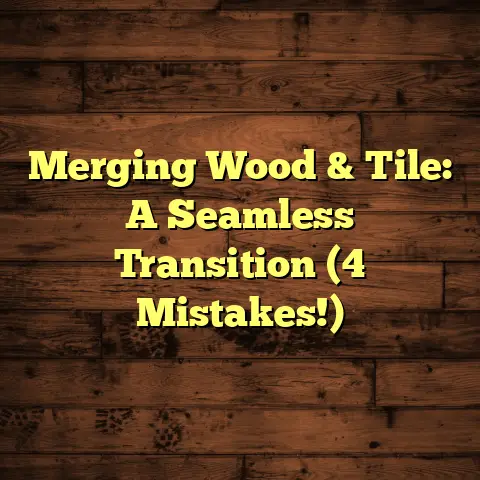How To Get Rid Of Urine Smell From Floorboards? (Explained)
When dealing with the unpleasant issue of urine smell in floorboards, budgeting for the right cleaning solutions and repairs is essential.
I often find myself balancing between cost-effective methods and more comprehensive approaches when handling such situations.
My experience has shown that while DIY solutions can save money initially, sometimes, investing in professional-grade products or services pays off in the long run.
Identifying the Cause
First things first, I always try to identify the source of the odor.
Is it from a pet accident, a spill, or perhaps an unseen leak?
Understanding where the smell is coming from helps me determine the best approach.
For instance, I once had a client whose cat had repeatedly urinated in a corner of their living room.
After some investigation, I discovered that the problem was not just surface-level but had soaked into the floorboards.
This situation highlights the importance of thorough inspection.
I often get down on my hands and knees, checking for discoloration or wet spots that might indicate deeper issues.
It’s amazing how often people overlook these signs until the smell becomes unbearable.
Quick Fixes for Immediate Relief
For quick solutions, I’ve relied on a few household items.
Baking soda is a go-to for absorbing odors.
Simply sprinkle it liberally over the affected area and let it sit for several hours or overnight.
Afterward, vacuum it up.
Vinegar is another effective option; its acidity neutralizes odors.
Mixing equal parts vinegar and water in a spray bottle can work wonders.
However, I always ensure to test it on a small, inconspicuous area first, especially with wood floors, to avoid any damage.
In one memorable incident, I had a client who was desperate for an immediate solution after their puppy had an accident on their new laminate flooring.
I suggested using baking soda and vinegar as they were readily available and non-toxic.
The next day, they called me thrilled to report that the smell had significantly decreased.
It’s moments like this that remind me of the power of simple household items.
Cleaning Agents
I prefer using enzymatic cleaners specifically designed for pet odors.
These cleaners break down the proteins in urine that cause the smell.
They can be found at pet stores or online.
One product I’ve found particularly effective is Nature’s Miracle.
It’s safe for various flooring types and works well on both fresh and old stains.
- Application Tips: Always saturate the area thoroughly and allow it to air dry to ensure deep penetration into the floorboards.
I usually recommend applying it in the evening so it can work overnight. - Follow-Up: After using any cleaner, ventilating the space helps dissipate lingering odors.
During my years as a flooring contractor, I’ve tried numerous products, but enzymatic cleaners have consistently delivered results.
I remember one job where a family had given up hope on their hardwood floors after multiple cleaning attempts failed.
After applying an enzymatic cleaner, they were amazed at how effective it was—no more odors and their floors looked revitalized.
Dealing with Stains
Sometimes, the smell lingers even after cleaning.
This often means that urine has penetrated deeper into the wood or subflooring.
In such cases, I’ve had success with a more involved approach:
- Sanding: If the floorboards are hardwood, light sanding can remove surface stains and odors.
However, this requires careful handling; too much sanding can damage the finish.- Tools Needed: A random orbital sander with fine-grit sandpaper works well for this task.
- Technique: Sand with the grain of the wood to avoid scratches.
- Refinishing: For more severe cases, refinishing the affected boards might be necessary.
This involves sanding down to bare wood and applying a new finish.
I recall a project where an elderly couple had suffered from a recurring odor in their hardwood living room floor.
After some discussion, we decided on sanding and refinishing the affected boards.
The process took about two days, but once completed, they were thrilled with not only the lack of odor but also the renewed appearance of their floors.
Replacing Floorboards
In extreme cases where damage is extensive, replacing floorboards may be the only option left.
During one project, I faced a significant challenge when I discovered that a portion of the subfloor had been compromised by long-term exposure to moisture and urine.
- Cost Considerations: Depending on the type of flooring and labor, replacing floorboards can range from $3 to $12 per square foot, including materials and installation.
- DIY vs.
Professional Help: I often weigh my options here; while I have the skills to replace boards myself, hiring a professional ensures a seamless finish.
In this particular case, we replaced several boards in a high-traffic area that had absorbed too much moisture over time.
The client was initially hesitant about the cost but appreciated my transparency regarding materials and labor involved.
Using FloorTally for Cost Estimation
When tackling any flooring project, I’ve found FloorTally invaluable for cost estimation.
It allows me to input various flooring types and get accurate material and labor costs based on local rates.
Recently, I used it for a project that involved both cleaning and potential board replacement:
- The platform helped me visualize all costs involved—cleaners, materials for replacement, and labor—allowing me to provide my client with a transparent budget.
- This not only instilled confidence in them but also enabled me to plan my finances better.
Moreover, when I input different scenarios—like replacing just a few boards versus refinishing an entire room—the software quickly adjusted estimates based on my inputs.
This feature has saved me countless hours of manual calculations.
Long-Term Maintenance
To prevent future issues with odor, regular maintenance is crucial.
Here are some tips I follow:
- Prompt Cleaning: I always recommend addressing spills or accidents immediately to prevent seepage.
- Sealing Floors: Depending on the type of flooring, applying a sealant can create a barrier against moisture absorption.
- Regular Inspections: Keeping an eye on high-traffic areas helps catch any potential problems before they escalate.
During one particularly busy season, I worked on several homes with pets and children where accidents were frequent.
By sharing these maintenance tips with homeowners—like using doormats to reduce dirt and moisture brought inside—I noticed a significant decline in odor-related complaints.
Learning from Experience
Over my years as a contractor, I’ve learned that every situation is unique.
I once tackled a job where my client had young children and pets—an ongoing battle with odors!
By combining cleaning products with preventive measures like area rugs and regular deep cleaning sessions, we managed to keep their home smelling fresh.
Additionally, educating clients about choosing pet-friendly flooring options can make a significant difference in long-term maintenance and odor prevention.
For example, tiles or vinyl are often easier to clean than carpets.
Comparing Options
Throughout my experience, I’ve tried various methods for tackling urine odors in flooring:
- Enzymatic Cleaners vs.
DIY Solutions: While DIY options like vinegar and baking soda work for immediate relief, enzymatic cleaners provide a more thorough solution by breaking down odor-causing compounds. - Sanding vs.
Replacement: Sanding can be effective for minor stains but may not suffice if urine has penetrated deep into the subfloor or if boards are damaged beyond repair.
In one particularly challenging job involving heavily stained carpet tiles that had absorbed pet urine over time, we attempted cleaning first but ultimately decided replacement was necessary due to persistent odor issues.
Additional Tools and Techniques
Over time, I’ve accumulated various tools that make handling these situations more manageable:
- Moisture Meters: These devices help identify moisture levels in wood floors or subflooring.
- Dehumidifiers: Installing these can help reduce overall humidity in homes prone to moisture issues.
- Air Purifiers: Using one during cleaning sessions can help eliminate lingering smells from the air.
Case Studies: Successes and Challenges
Reflecting on specific projects provides valuable insights into what works best:
- Case Study 1: Family Home with Multiple Pets
- Challenge: Persistent odor despite regular cleaning.
- Solution: We used an enzymatic cleaner followed by replacing affected boards.
- Outcome: Odor eliminated; family was relieved and happy with the result.
- Case Study 2: Rental Property
- Challenge: New tenants complained about lingering pet odors.
- Solution: Conducted thorough cleaning followed by sealing floors.
- Outcome: Tenants reported no further issues; landlord appreciated increased property value.
These experiences illustrate how adaptable solutions are necessary for different types of flooring issues.
Conclusion
Getting rid of urine smell from floorboards can be challenging but manageable with the right approach and tools.
Whether you opt for DIY solutions or professional help depends on your specific situation and budget constraints.
Always remember to assess each case individually, consider long-term effects, and keep communication open with your clients—this builds trust and leads to better outcomes.
Through trial and error, I’ve gathered enough insights to navigate these challenges effectively.
If you’re facing similar issues, I hope these tips can guide you toward a fresher-smelling home!
Have you recently dealt with this issue?
What solutions have worked for you?
Additional Insights for Clients
As someone who frequently interacts with homeowners facing flooring dilemmas, it’s important to foster open communication about expectations regarding odor removal solutions:
- Setting Realistic Expectations: While many products advertise quick fixes, sometimes thorough cleaning or replacement is necessary for lasting results.
- Understanding Flooring Types: Different flooring materials react differently to cleaning methods; knowledge about these nuances helps avoid further complications down the road.
I encourage clients to share their experiences as well—understanding what has worked or failed for others can provide new insights into tackling similar challenges together.
Bonus Tips
- Consider Routine Maintenance Plans: For homes with pets or children prone to accidents, establishing routine maintenance schedules may prevent future issues.
- Invest in Quality Products: Although it may seem tempting to save money on cheaper cleaners or materials upfront, investing in quality products often leads to better long-term results.
- Educate Yourself About Your Flooring: Knowing how your specific flooring type interacts with various cleaning methods will empower you to choose wisely when tackling odor issues.
By taking these steps proactively, homeowners can create healthier living environments free from unwanted odors while extending the life of their flooring investments!





